In short
The Tamron Di II SP 17-50mm F / 2.8 VC is a balanced fast universal zoom lens for cropped cameras. An alternative for more expensive Nikon DX AF-S Nikkor 17-55mm 1: 2.8G ED IF SWM и Canon Zoom Lens EF-S 17-55mm 1: 2.8 IS USM.
Tamron Di II SP 17-50mm F / 2.8 VC is a significant upgrade to an older version Tamron 17-50mm F / 2.8 XR Di II LD Aspherical (IF). The main innovation is the availability of the image stabilizer Tamron VC.
Tamron Di II SP 17-50mm F / 2.8 VC is available only for Nikon (model B005 N II) and Canon (model B005 E) cameras.
In general, the Tamron Di II SP 17-50mm F / 2.8 VC is on par with a similar third-party lens - Sigma DC 17-50mm 1: 2.8 Zoom EX OS HSM,
The Tamron Di II SP 17-50mm F / 2.8 VC has been in my personal use for a long time as a 'workhorse' for crop cameras and left a good impression.
Key Features of Tamron Di II SP 17-50mm F / 2.8 VC:
| Review Instance Name | The lens barrel says 'Ø 72 Di II Tamron SP 17-50mm F / 2.8 B005 Made in Japan 110612' |
| Basic properties |
|
| Front Filter Diameter | 72 mm |
| Focal length | 17-50 mm EGF for Nikon DX cameras is 25.5-75 mm |
| Zoom ratio | 2.94 X (often rounded to three) |
| Designed by | for Nikon DX cropped digital cameras |
| Number of aperture blades | 7 rounded petals that form a fairly even hole |
| Tags | focusing distance in meters and feet, focal lengths for 17, 24, 35, 50 mm, hood attachment mark, bayonet mount mark |
| Diaphragm | from f / 2.8 over the entire range of focal lengths to f / 32. The lens does not have an aperture ring (G - lens type for Nikon cameras) |
| MDF | 0.29 m, maximum magnification ratio 1: 4.8 (at a value of 50 mm focal length) |
| The weight | 570 g |
| Optical design | 19 elements in 14 groups of which:
Clickable Image |
| Lens hood | Supplied petal hood, AB003 |
| Manufacturer country | MADE IN JAPAN (but there are lenses made in China) |
| Price | |
| Period | From September 17, 2009 to the present day |
Assembly
Tamron Di II SP 17-50mm F / 2.8 VC is made only in Japan. To the touch the lens is pleasant, strong, weighty. The retractable frame of the body ('trunk') consists of one section, which is strong enough, without any backlash. To the touch Tamron Di II SP 17-50mm F / 2.8 VC is much better than its previous model Tamron 17-50mm F / 2.8 XR Di II LD Aspherical (IF).
The lens has metal bayonet mount. The zoom and focus rings are rubberized. Changing the focal length runs smoothly. The zoom ring can rotate quite tight for the first time.
There is a bayonet mount mark and a mark on the case for quick installation of the hood. The lens uses a plastic hood, which is fixed in special grooves located near the front lens of the lens. The hood can be installed in the opposite direction for transportation. In this position, access to the focus ring at 17 mm focal length is lost. When you change the focal length, the lens hood moves with the front of the lens.
When changing the focal length, the rear lens moves in the middle of the lens body like a pump - it draws in and pushes out air. This behavior of the rear lens is called 'vacuum cleaner effect', which can increase the amount of dust that accumulates in the camera.
The number of diaphragm blades is 7 pieces. At the same time, they are slightly rounded and already form a heptagon on strongly covered diaphragms.
For Tamron Di II SP 17-50mm F / 2.8 VC, the direction of rotation of the zoom and focus rings coincides with the direction of the original Nikon DX AF-S Nikkor 17-55mm 1: 2.8G ED IF SWM.
It is believed to be a lens from the Tamron SP professional line. Many professional lenses use the classic 77 mm filters, 72 and 82 mm - less often. The Tamron Di II SP 17-50mm F / 2.8 VC has 72mm filters.
Despite the good build of the Tamron Di II SP 17-50mm F / 2.8 VC, the overall reliability of the lens is very much inferior to the original metal super-lens Nikon 17-55 / 2.8G.
Repair masters claim that the internal implementation of the lens assemblies is not very good. Personally, I was faced with the fact that with a light blow, the section on which the focus and stabilizer switches are mounted broke completely. This section is made of very thin prastik.
Lock 'LOCK ′
Frame (trunk) at Tamron Di II SP 17-50mm F / 2.8 VC does not spontaneously change its size under its own weight (perhaps this can only begin with time). To prevent future inconveniences, a focal length switch 'LOCK' (the so-called 'lock') is present on the lens body, which tightly locks focal length at a value of 17 mm.
To fix the trunk of the lens, you must first set the 17 mm focal length. Near the button there is a drawn arrow that indicates in which direction the switch should be moved to lock the lens.
The switch is located in a convenient place - under the thumb of the left hand, so the lens can be quickly and comfortably 'removed from the lock' before starting shooting.
The effect of spontaneous changes in focal length (trunk creep) in this lens is quite noticeable.
Focusing
For focusing, the lens uses a micro motor that is noisy. Tamron Di II SP 17-50mm F / 2.8 VC will automatically focus on all Nikon DX cameras.
When used on a camera Nikon D40, D80, D200, Nikon D90 with unpretentious focusing systems the lens behaved well. I had no particular problems with focusing accuracy and tenacity. The lens clings well to the subjects being shot, rarely refocuses. The number of focusing misses is minimal.
Auto focus speed average, comfortable for the vast majority of photo tasks. Focusing speed is significantly lower than the original Nikon DX AF-S Nikkor 17-55mm 1: 2.8G ED IF SWM. Let me remind you that Nikon 17-55 / 2.8G so far it is the fastest original lens in the Nikon DX series (it uses a large and powerful ring SWM motor).
The focusing speed of the Tamron Di II SP 17-50mm F / 2.8 VC is identical to the older version with the focusing motor (Tamron 17-50mm F / 2.8 XR Di II LD Aspherical (IF) A16 NII)
Focus on Tamron Di II SP 17-50mm F / 2.8 VC internal - when focusing, neither the front nor the rear lens rotates, and the lens itself does not change its size when focusing. Sorry, but during auto focus focus ring rotates and cannot be touched. In such Nikon lenses, the focus ring remains stationary during auto focus.
In manual focus mode, the focus ring rotates approximately 60 degrees. Manual focus is quite inconvenient. When extreme positions are reached, the focus ring abuts and cannot be rotated further.
With manual focus, if the focus ring is tightly clasped, the focus ring starts to jerk. To manually shift the focus ring, you have to make a considerable effort, after which the ring begins to move and flies over the desired value.
The minimum focusing distance is only 29 cm (the distance from the camera’s matrix to the subject). With such an MDF, the maximum magnification ratio is 1: 4.8.
The lens has focus mode switch 'AF / MF'. For manual focus, the lens must be switched to 'M' mode, otherwise the focus motor may be damaged. Unfortunately, unlike many Nikon lenses of this type, Tamron Di II SP 17-50mm F / 2.8 VC does not support continuous manual focus mode.
Focus Features:
- There is a strong effect of 'Focus Breathing' (changing the viewing angle during focusing). During focusing towards MDF, the viewing angle increases.
- When changing the focal length, focusing is a bit confused.
- Unknown compatibility with teleconverters.
- Tamron Di II SP 17-50mm F / 2.8 VC does not have hard stop (hard infinity mechanical stop) which allows you to accurately and quickly focus the lens at infinity under any external conditions.
- The lens has a focus distance scale with marks in meters and feet. The scale is plotted on the focus ring. The scale is very meager, on it there are marks for only 6 values of the focusing distance (including 'infinity'). More advanced lenses usually use a scale in the form of a special window.
- Focus shift (shift-focus) was not noticed.
- Tamron Di II SP 17-50mm F / 2.8 VC has no focus problems in Live View (tested on Nikon D90 ), but focuses slowly.
- The lens transmits the focus distance to the subject in the camera (analog Nikon D, Nikon G).
- Tamron Di II SP 17-50mm F / 2.8 VC is a third-party lens. It may happen that it will not work correctly with some Nikon cameras. Details on this issue are considered by me. here.
Stabilizer
Tamron Di II SP 17-50mm F / 2.8 VC can use the built-in image stabilizer.
There is a VC ON / OFF stabilizer operation switch on the lens. The stabilizer works with noticeable noise.
The manufacturer does not indicate the effectiveness of the stabilizer. In practice, Tamron Di II SP 17-50mm F / 2.8 VC holds 2-3 stops on shutter speedwhich is quite good. I was able to take pictures of stationary objects from hand to hand without any problems shutter speed 1/15 sec and 50 mm focal length.
Nowhere is it indicated whether the stabilizer can track the movement of the lens during panoramic shooting. Unlike the original Nikon DX AF-S Nikkor 16-85mm 1: 3.5-5.6G ED VR SWM IF Aspherical Tamron Di II SP 17-50mm F / 2.8 VC has no choice of Active / Normal stabilization modes or the like
Important: during stabilizer activation (pressing the autofocus and / or metering activation button exposure) and during its deactivation (a few seconds after inactivity), the image in the viewfinder twitches noticeably. If you take a picture at this moment, you can get a blurry frame. To avoid this, you need to wait a bit after activating or deactivating the stabilizer.
Important: during shooting with the built-in flash with the stabilizer on, after each shutter release, the stabilizer turns off and on. Most likely this is due to the power consumption for charging the built-in flash. There is no such problem with an external flash.
Image quality
The lens is sharp in the center even at F2.8 and at all focal lengths, but still, it is far from fixed lenses. When you close the aperture to F3.5, contrast increases markedly. Closing to F5.6 sharply increases sharpness. The lens is very sharp on the F11-F16 aperture. Color reproduction is normal, the lens even boasts a nice nice bokeh at 50mm and F2.8. HA visible only 17 mm. If you really need it, then at 50 mm F2.8 you can shoot portraits, but even Nikon 50mm F1.8D a portrait will do better. A serious drawback of the image quality of the lens is distortion, which almost disappears by 50 mm. The lens also has a strong vignette of 17 mm (in the vicinity of the step at the edges of the frame) and a little smaller by 50 mm.
Sample Photos
The lens below is shown under real-world camera shooting conditions. Nikon D90:
You can take a look at a lot of photos from real shootings. here, here, here и here.
Personal impressions
The Tamron Di II SP 17-50mm F / 2.8 VC is a usable lens. But still Sigma DC 17-50mm 1: 2.8 Zoom EX OS HSM I like it more. There are several reasons: a quieter focusing motor of a different type, fewer problems with the focusing ring, and there is no jerking of the picture when the stabilizer is turned on. At the same time, for a long time I used Tamron Di II SP 17-50mm F / 2.8 VC for professional purposes and was completely satisfied with its optical performance and general capabilities.
Prices for the Tamron 17-50mm F / 2.8 XR Di II VC LD Aspherical (IF) lens in popular online stores can look at this linkor in the price block located below:
All Tamron 17-50 prices
Comments on this post do not require registration. Anyone can leave a comment. Many different photographic equipment can be found on AliExpress.
All fast universal zoom lenses
Below is a list of all such aperture-type universal zoom autofocus lenses for SLR and mirrorless cameras with an APS-C sensor or less.
Tokina (DX, various mounts)
- Tokina AT-X PRO SD 16-50 F2.8 DX Internal Focus, model AT-X 165 PRO DX, for Canon (C/EF version) and Nikon (N/AIS version), from July 2006. Optical design is the same as Pentax SMC DA* 16-50mm f/2.8 ED AL (IF) SDM
Tamron (DI II, DI III-A, various mounts)
- Tamron Aspherical LD XR DI II SP AF 17-50 mm 1: 2.8 [IF], model A16 N / E / P / S (under Nikon [N], Canon [E], Pentax [P], Sony / Minolta [S]), since February 2006. Produced in Japan, China and Vietnam
- promaster DIGITAL XR EDO AF Ashperical LD [IF] 17-50 mm 1: 2.8 MACROprevious lens under the brand Promaster
- Tamron Aspherical LD XR DI II SP AF 17-50 mm 1: 2.8 [IF], model A16 NII (only for Nikon cameras), since March 2008
- Tamron Di II SP 17-50 mm F / 2.8 VC B005, model B005 E / NII (for Canon [E] or Nikon [NII]), from September 2009, Japan or China)
- Tamron 17-70 mm F / 2.8 Di III-A VC RXD Model B070, Model B070, Sony E only, from December 2020
Sigma (DC, different mounts)
With constant maximum aperture (DC EX and DC ART series):
- Sigma DC ZOOM 18-50mm 1: 2.8 EX (+ -D), since July 2004, for Sigma SA, Nikon F, Canon EFS, Pentax K. The version for the '4/3' system has been available since February 2006 (not mass-produced). The version for Nikon in its name includes the prefix 'D'.
- Sigma dc 18-50mm 1: 2.8 EX MACRO, since September 2006, for Sigma SA, Nikon F, Canon EFS, Pentax K, 4/3
- Sigma dc 18-50mm 1: 2.8 EX MACRO HSM, since June 2007, for Nikon DX cameras only (Nikon F mount)
- Sigma dc 17-50mm 1: 2.8 ZOOM EXOS HSM, from February 2010, for Sigma SA, Nikon F, Canon EFS, Pentax K, Sony / Minotla A
- Sigma dc 18-35mm F1.8 A [ART, HSM], from April 2013, for Sigma SA, Nikon F, Canon EFS, Pentax K, Sony / Minotla A
- SIGMA DC 18-50 mm 1: 2.8 DN C [Contemporary], since Oct 2021, for Sony E, Leica L
With variable maximum aperture (DC and DC Contemporary series):
- Sigma dc 17-70mm 1:2.8-4.5, February 2006, for Sigma SA, Nikon F, Canon EFS, Pentax K, Sony / Minotla A
- Sigma dc 17-70mm 1:2.8-4.5 MACRO HSM, from July 2007, for Nikon DX cameras only (Nikon F mount)
- Sigma dc 17-70mm 1:2.8-4 MACRO HSM OS, from December 2009, for Sigma SA, Nikon F, Canon EFS, Pentax K, Sony / Minotla A
- Sigma dc 17-70mm 1:2.8-4 C, [MACRO, OS, HSM, Contemporary], from September 2012, for Sigma SA, Nikon F, Canon EFS, Pentax K, Sony / Minotla A
- Sigma dc 18-50mm 1:2.8-4.5 HSM OS ZOOM, from March 2009, for Sigma SA, Nikon F, Canon EFS, Pentax K, Sony / Minotla A
Nikon (DX, F mount)
- Nikon DX VR AF-S Nikkor 16-80mm 1:2.8-4E ED N, Nikon F mount, from July 2015
- Nikon DX AF-S Nikkor 17-55mm 1: 2.8G ED IF SWM, Nikon F mount, from July 2003
Pentax (DA, Q, K and Q mounts)
- Pentax SMC DA * 16-50 mm 1:2.8 ED AL (IF) SDM, Pentax KAF2 mount, since February 2007. Optical design is similar to the lens Tokina AT-X PRO SD 16-50 F2.8 DX Internal Focus (joint development of Tokina and Pentax)
- HD PENTAX-DA * 1: 2.8 16-50 mm ED PLMAW, from July 2021, Pentax KAF4 mount
- HD Pentax-DA 1: 2.8-4 20-40 mm ED Limited DC WR, Pentax KAF3 mount, black or silver body, from November 2013
- SMC Pentax 1: 2.8-4.5 5-15 mm ED AL [IF] [LENS 02], Pentax Q mount (crop factor Kf=5.53X or Kf=4.65X)
Canon (EFS, EF-S mount)
- Canon Zoom Lens EF-S 17-55mm 1: 2.8 IS USM (Image Sabilizer, Ulstrasonic, EFS), Canon EF-S mount, since May 2006
Sony (DT, A and E mounts)
- Sony DT 2.8/16-50 SSM, Sony A mount (Minolta A), since August 2011
- Sony E 2.8/16-55G (Sony SEL1655G), Sony E bayonet mount, from August 2019
Fujifilm(X)
- Fujinon Ashperical Lens Nano-GI XF 16-55mm 1: 2.8 R LM WR, Fujifilm X mount, since January 2015
- Fujinon Ashperical Lens Super EBC XF 18-55mm 1:2.8-4 RLM OIS, Fujifilm X mount, September 2012
Samsung (NX)
- Samsung lens 1: 2-2.8 S 16-50 mm ED OIS i-Function, Samsung NX mount, since January 2014
Olympus/Panasonic/Leica/Yongnuo (4/3, Micro 4/3, Kf=2X)
Mirrored 4/3:
- OLYMPUS ZUIKO Digital 11-22 mm 1:2.8-3.5, from February 2004
- OLYMPUS Digital 14-54 mm 1:2.8-3.5, from June 2003
- OLYMPUS Digital 14-54 mm 1:2.8-3.5 II, from November 2008
- OLYMPUS ZUIKO Digital 14-35 mm 1: 2 ED SWDsince January 2005
- Panasonic Lumix LEICA D VARIO-ELMARIT 1: 2.8-3.5 /14-50 ASPH. MEGA OIS, from July 2006
Mirrorless Micro 4/3:
- OLYMPUS M.ZUIKO DIGITAL 12-40 mm 1:2.8 PRO, since October 2013
- Panasonic Lumix Leica DG Vario-Summilux 10-25 mm f / 1.7 ASPH.since May 2019
- LUMIX G VARIO 1: 2.8 /12-35 ASPH. POWER OIS, since June 2012, in March 2017 an improved sub-version is released (outwardly they do not differ in any way)
- Panasonic Lumix Leica DG Vario-ELMARIT 1: 2.8-4.0 /12-60 ASPH., since March 2017
- Yongnuo 12-35 F2.8-4 STM ASPH, since April 2023
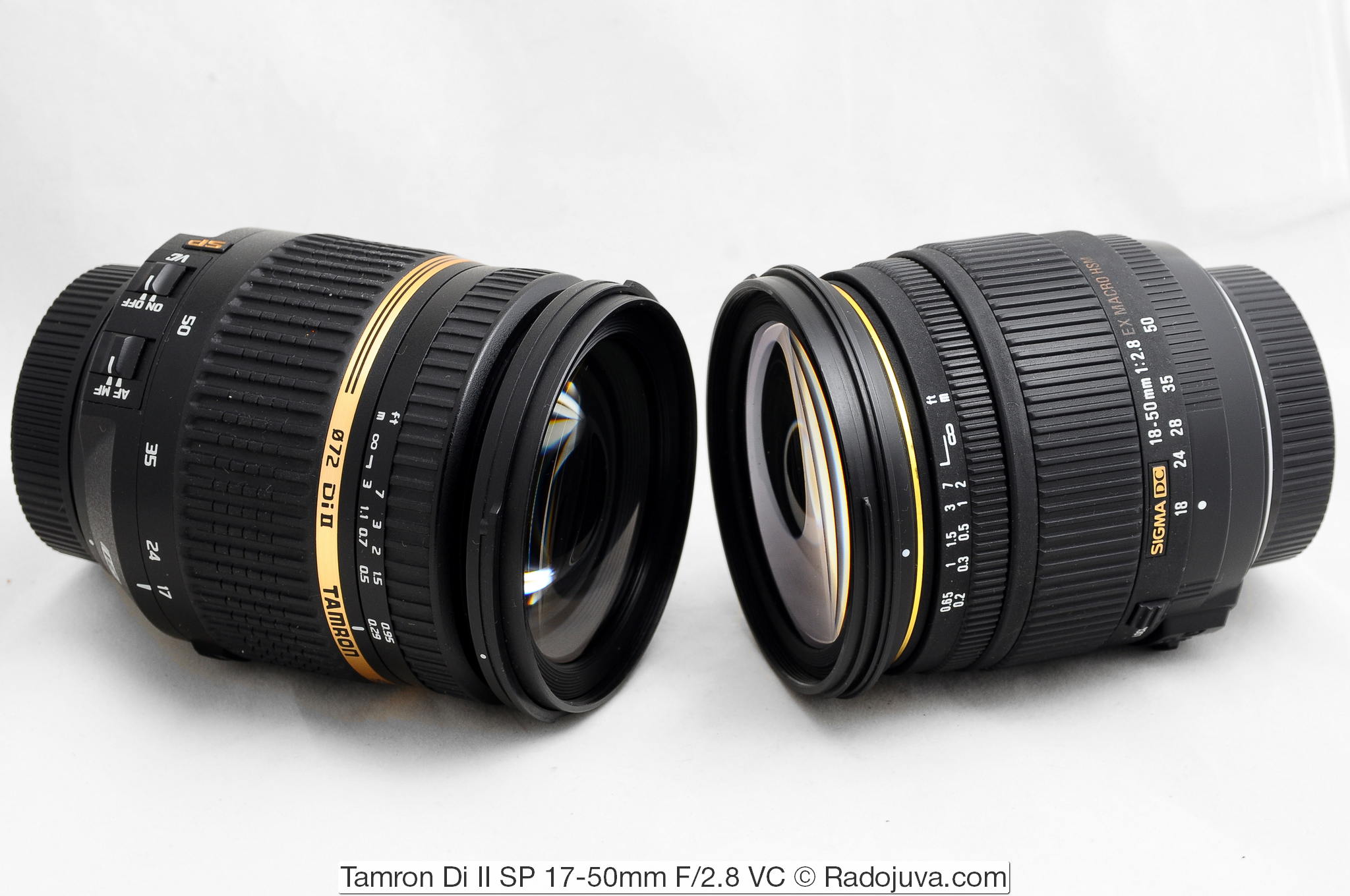
Tamron Di II SP 17-50mm F / 2.8 VC and Sigma DC 18-50mm 1: 2.8 EX MACRO HSM
Conclusions
Tamron Di II SP 17-50mm F / 2.8 VC - balanced versatile fast lens with convenient focal lengths for DX cameras and an image stabilizer. Suitable as a good staffer for DX cameras.
Material prepared Arkady Shapoval. Training/Consultations | Youtube | Facebook | Instagram | Twitter | Telegram

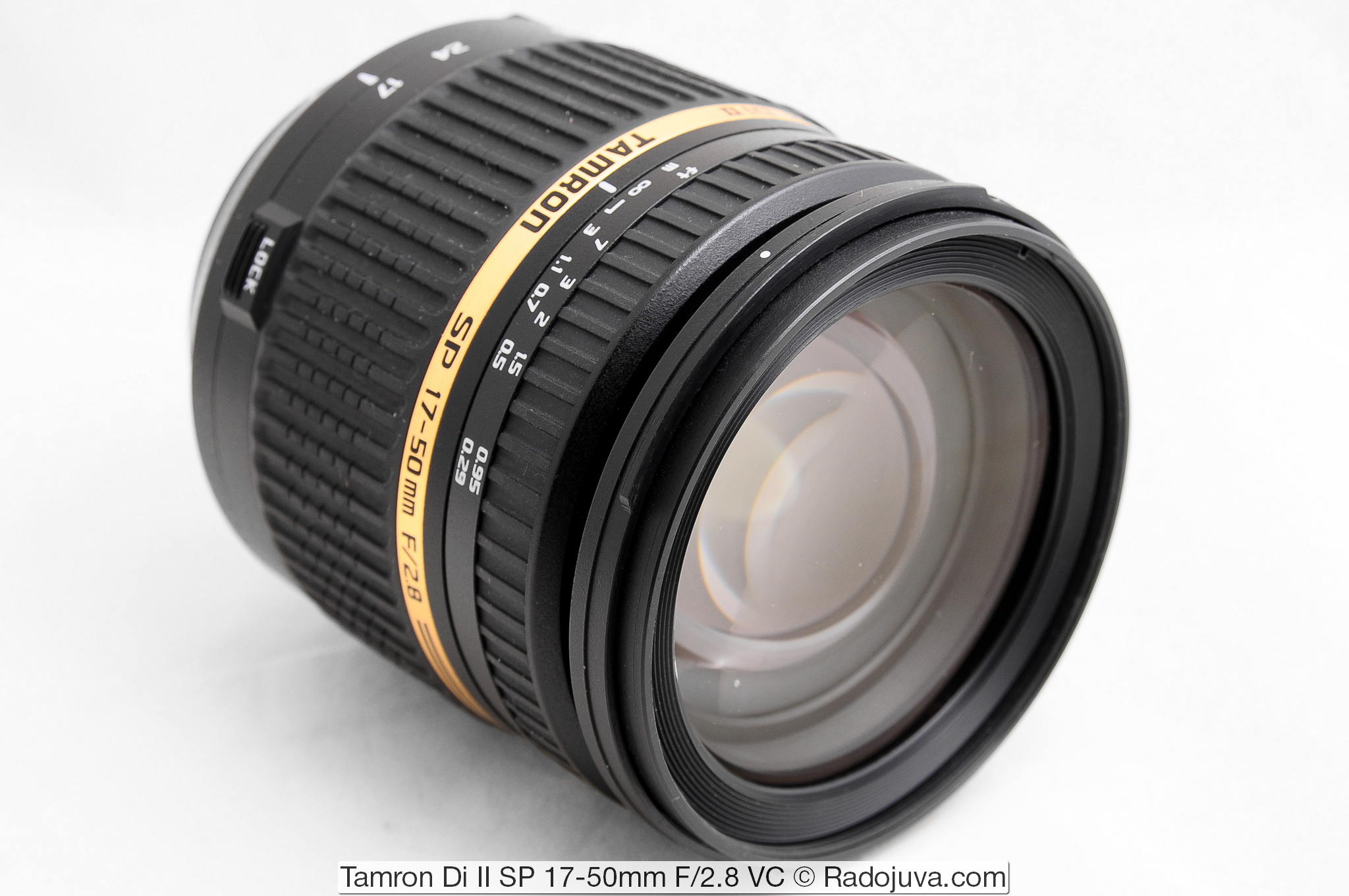
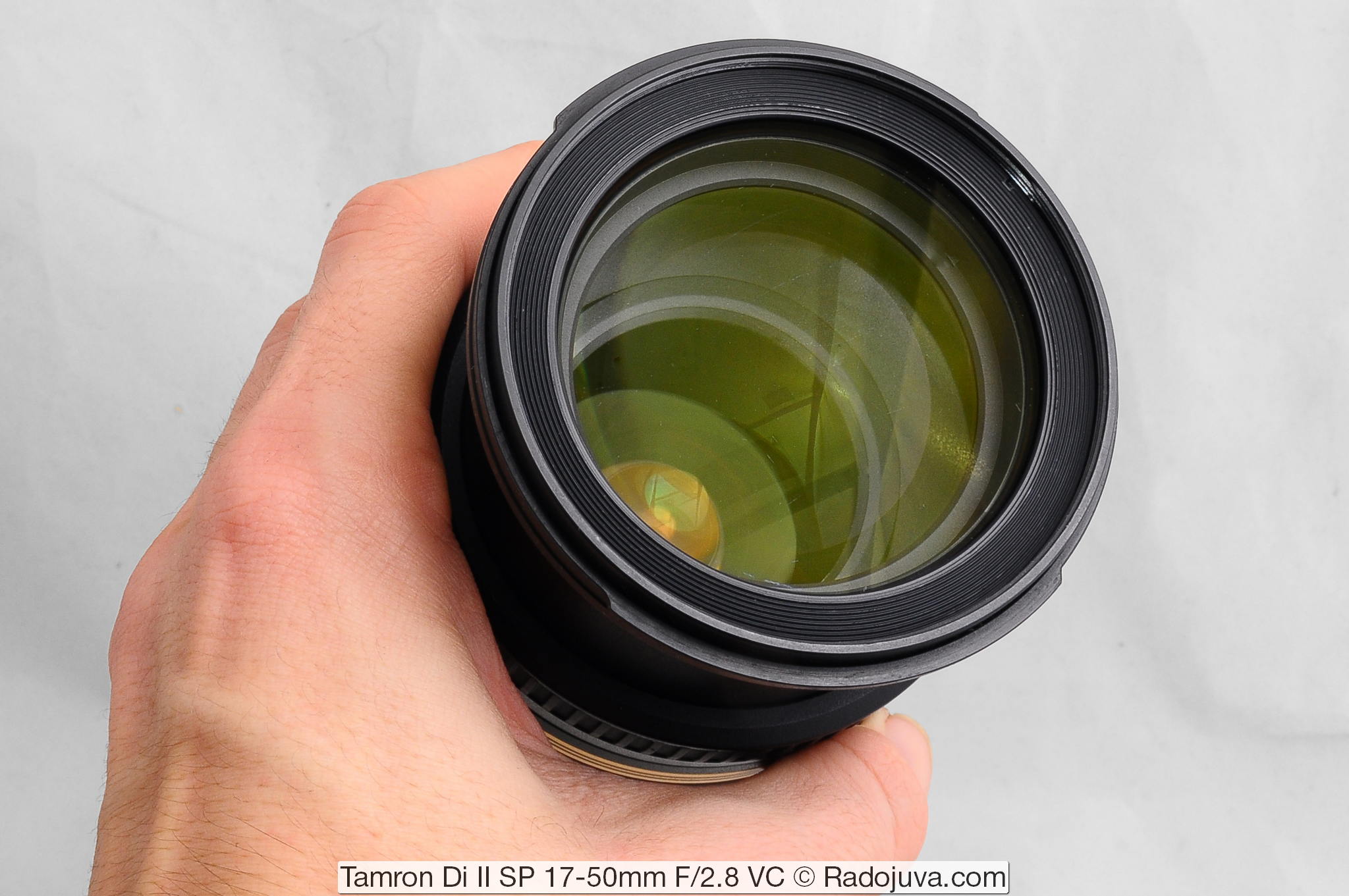
![Optical design SP AF 17-50mm F / 2.8 XR Di II VC LD Aspherical [IF]](https://radojuva.com/wp-content/uploads/2018/02/tamron-17-50-vc-optical-scheme-big-300x263.jpg)
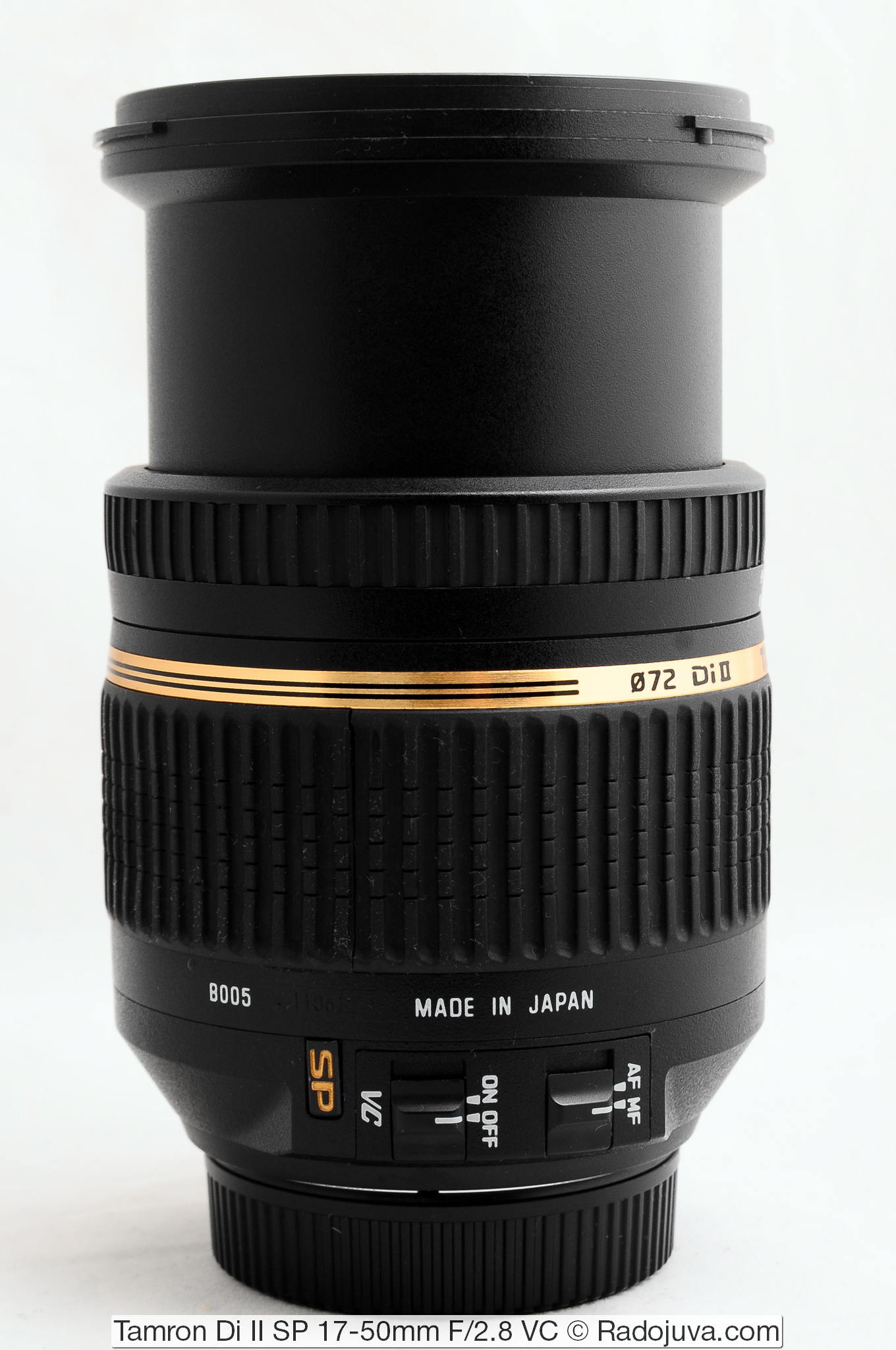

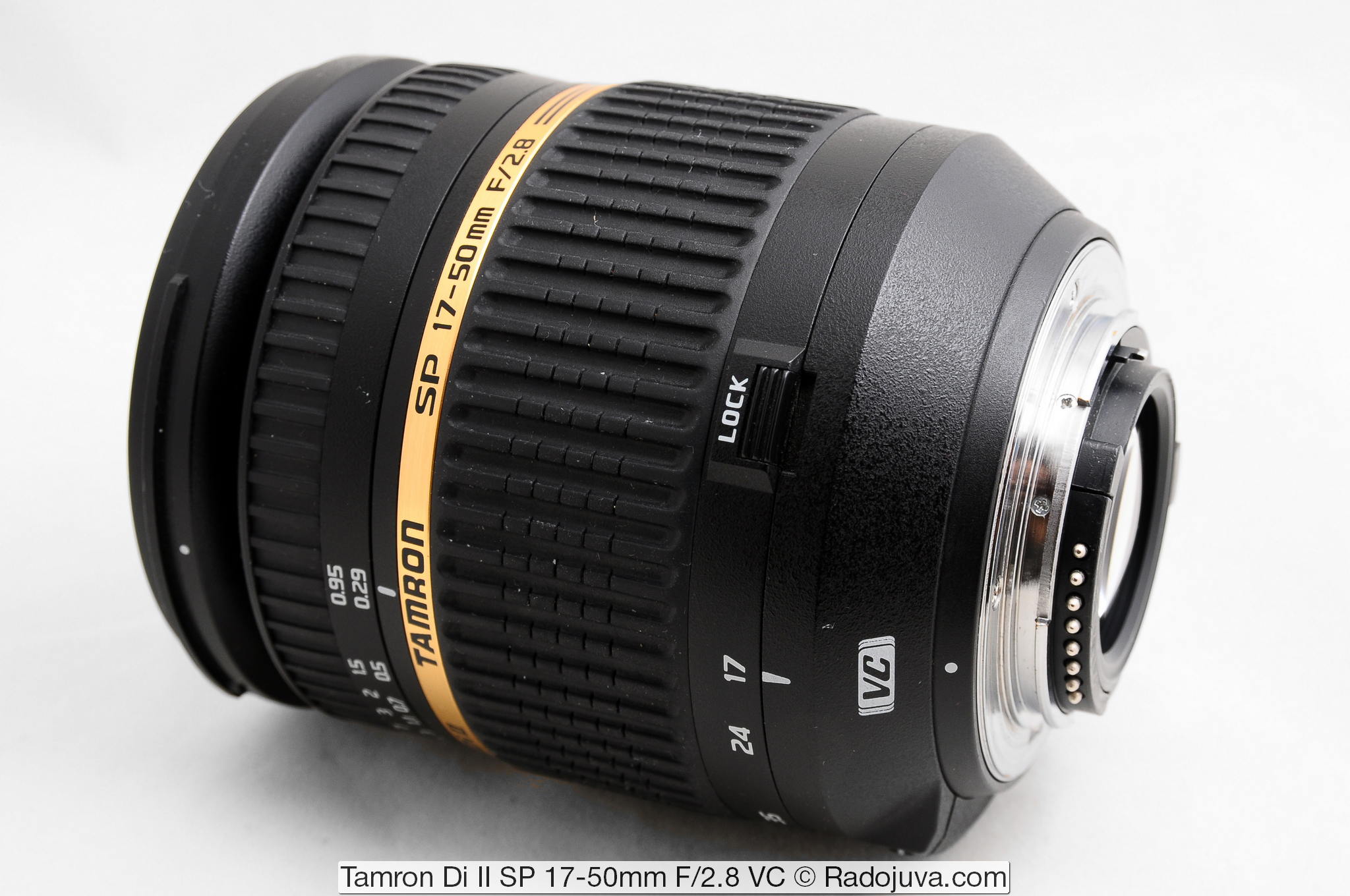
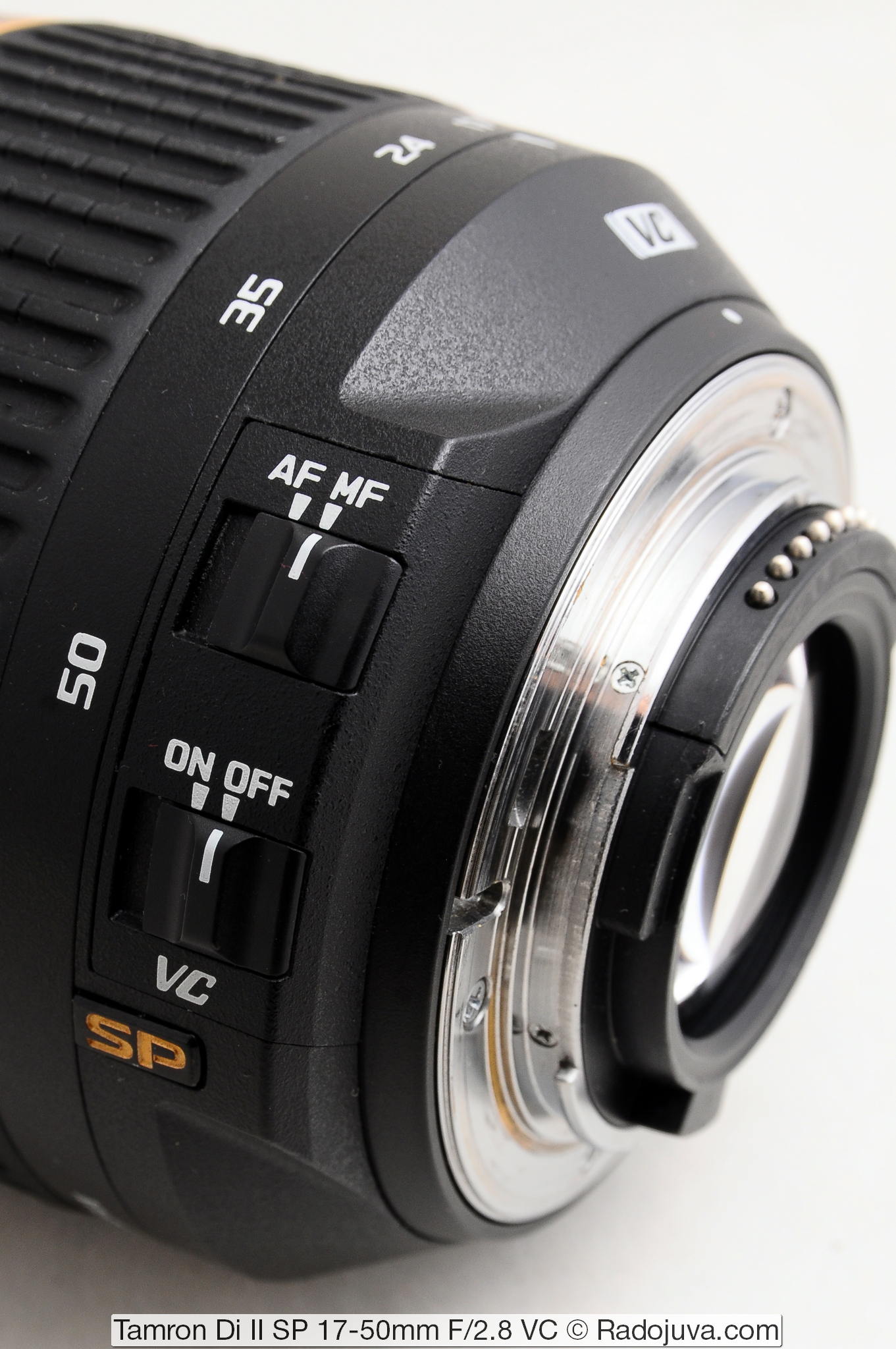
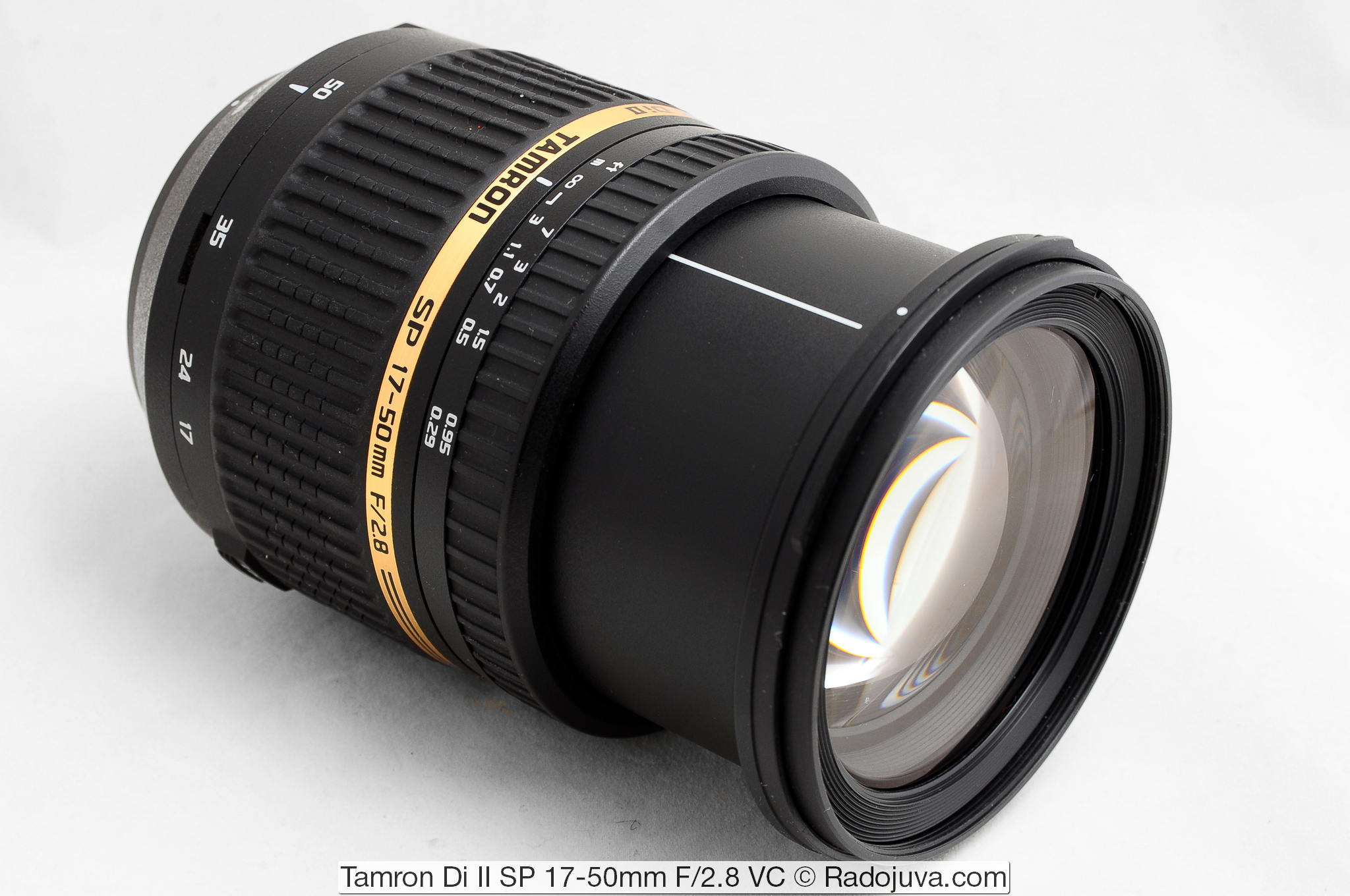






























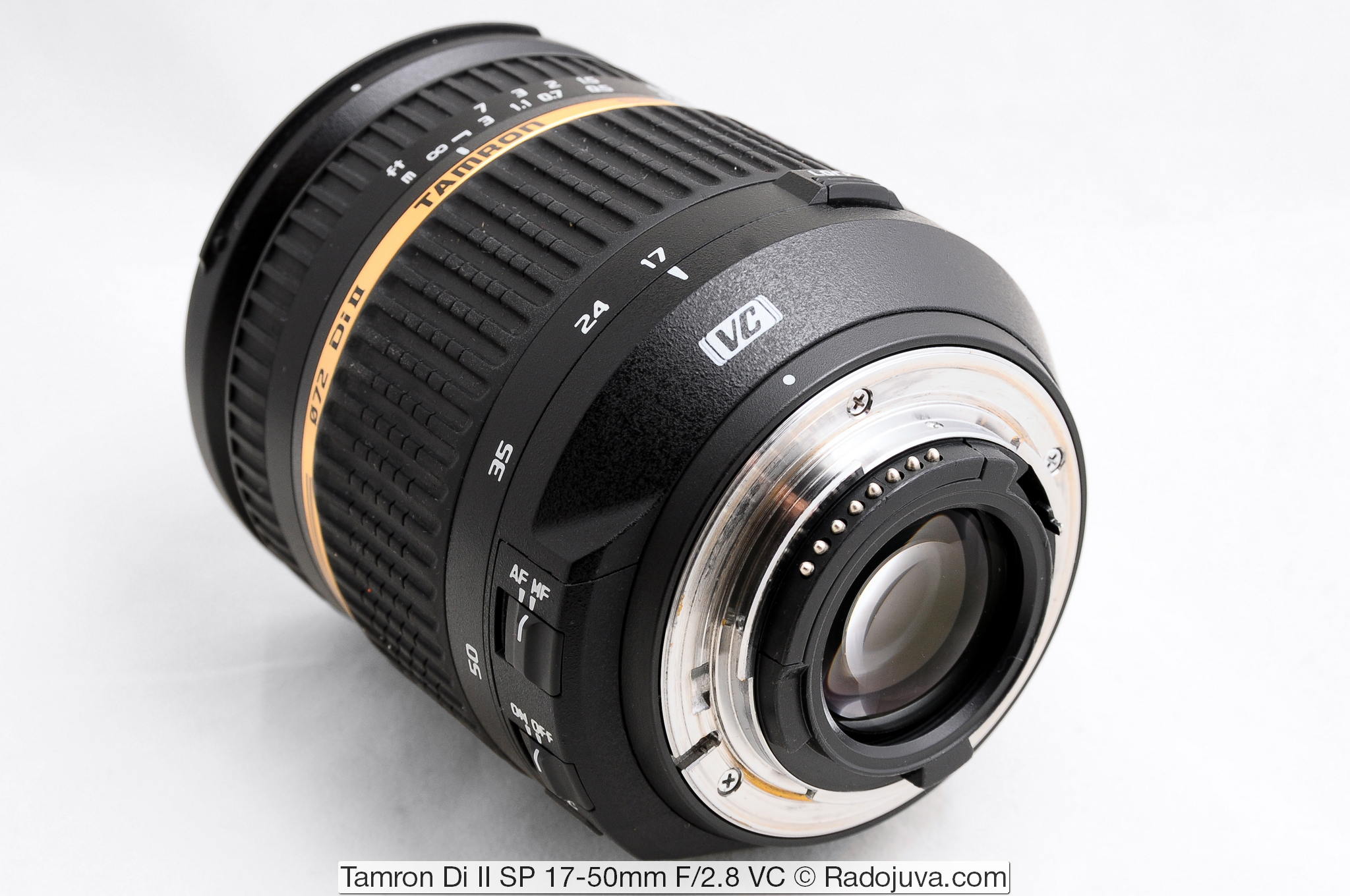

What is the best light filter to use with this Marumi DHG Lens Protect or Hoya HD UV lens?
I would take Marumi DHG Lens Protect, which is better - it's hard for me to judge.
Thanks, then I take Marumi)
I read a lot of discussions on forums about which lens is better, with or without a stub. Many write that a model with a stub is a losing option, since, surprisingly, the previous model without a stub gives a sharper picture. but with a stub less sharp + noise. What can you say about this? Is it so?
I will say that there is a spread in quality. There are good, there are bad, hard to find good.
So why pay more? =) Thank you!
Is it possible to take a Tamron AF 17-50mm f / 2.8 SP XR Di II LD Aspherical [IF] VC lens for a Sony SLT-A57 body carcass, or can I take it without an image stabilizer? If this lens is not suitable for Sony SLT-A57 body, then what would you recommend (in the same price / quality segment)?
Thanks in advance for your advice!
Yes, you can take it, only it must be for SONY.
I took myself a canon550, a very decent lens, my money is -100 percent.
Good day! having bought such an asset for canon 60D 2 months ago, wait for the problem of balance of the big one, it’s not irrelevant to the big one in the picture, the photo has been overexposed, the whole one has frowned at 3,5f 18-200, that’s not a problem. I mainly know people, help me with joy. Crazy!
This is more of a problem with setting up the camera and operating the exposure meter. Sigma is much darker, therefore it is easier to average the light and dark areas of the camera.
I’m so zrozumіv, what needs to be read read through the diaphragm, I’ve taken a photo at the evening at most hours before delivery! barely in the main, by the lens of pleasures, gowns, I’ll read through the corridor, dyaky for vіdpovіd.
Arkady if you compare the lens which in the review with the Nikon fix 35 / f1,8 in your opinion what result would be better at a focal length of 35mm, if you compare these two lenses.
Thanks in advance.
Niccor is much sharper. Nikonovskaya 35tka is very good, Tamron loses a lot at 35mm both in aperture ratio and other parameters.
Thanks for the answer
this one for the club how will it be?
not bad, right?
Not so bad.
Arkady, your advice, I’ve been filming for more than 6 years
D80 Nikkor 24-85 f2.8-4. + Sigma 70-300.
Does it make sense to change Nikkor to the above Tamron 17-15, I use it for home and travel. Also read your recommendations on the D300S, D7000, I think to switch to the D7000. thanks
I would not change, the meaning is only in a wide angle.
Hello Arkady. And you did not use Tamron AF 18-200mm F / 3,5-6,3 XR Di II LD Aspherical [IF] MACRO? Can you replace the whale with your taste?
Hello. The lens is not used, the lens can replace the whale.
Hello. Tell me, what kind of EGF will Tamron AF 17-50mm f / 2.8 be on the Nikon D7000 and why can’t it be used on full-frame cameras? You write that the lens is only suitable for Nikon DX APS-C cameras, but there are no DX letters on the lens. Thanks in advance.
This is a third-party lens, it has its own marking system - https://radojuva.com.ua/2012/03/different-lens-main/ not like native Nikon lenses. The review has already indicated that EGF is 25,5-75mm. This lens is not designed for FX cameras, and will only work properly on Nikon DX APS-C cameras.
Please tell me as a beginner, EFR on the crop is recounted on all lenses (I mean the Nikkor 18-105 kit on the Nikon D7000), if so, tell me that it is better to take a fast lens 17-50 / 2,8 or 24-70 / 2,8 , 18 since I do not use a focal length of 105-18 on a whale lens 24-XNUMX. Thank you in advance for your advice!
EGF for crop should be recounted for all lenses. If you do not use 18-24, then 24-70 2.8 is better.
I have been reading you for a long time and with interest. So the question arose. Should I change the whale Sony 18-55 SAM (Sony A500) to Tamron 17-50? I rent travels, more mountains, landscapes. Sometimes mornings and weddings (as a friend, a newlywed photographer, in parallel with a pro photographer), as well as portraits. thanks
I would change, after all, 50 2.8 can stretch a portrait much better than 55 5.6
Ah Arkady !!! To get to your students !!! And then I read and study on my own, I have been taking photos for a long time :), but I still know that I know nothing. And the more I study, the more remains. A merciful one who knows nothing :) :) :). Thanks!!!
If you read my articles, then you have already hit :) :)
And here's another question, a little off topic, but still, what kind of flash would you recommend, Metz 50 or Metz 52. In the latter, the tactile screen is a little annoying. What do you think
I did not encounter these flashes, I can not tell.
I have Metz 50 Af-1 for Son_, so it is written on it.
The German did not want to write a completely different brand).
So the puff is good. My friend has 58 AF-1, they somehow tested in the room 20 sq.m. and they didn’t see the difference. And they came to the Metz since all Sony have a problem with desynchronization. A German whose products are produced at one factory in Germany is very good !!! 52 did not try, but 58 and 50 are excellent models and what is important is much cheaper than Sony, Nikon, Kenon
----------
http://photo-wed.blogspot.com/
there is a nikon d 7000 and a whale Nikon 18-105mm f / 3.5-5.6G ED VR AF-S DX Nikkor but after buying a Nikon 50mm f / 1.4G AF-S Nikkor I wanted a fast aperture like Nikon AF-S 28-70mm F2.8D (IF-ED) but unfortunately there is no money for such a gorgeous thing and even the incomes are not yet to afford. Which advise a cheaper aperture zoom to my nikon d 7000 I personally look towards Tamron AF 17-50mm f / 2.8 SP XR Di II LD Aspherical [IF] VC for Nikon (does it make sense to buy with a stabilizer, or overpay for an option) or take Tamron AF 28-75mm f / 2.8 SP XR Di LD Aspherical (IF) for Nikon scope wedding anniversaries, etc.
You can not overpay for a stub, 17-50 will be better for 28-75 at the wide end, and 28-75 is faster in focusing. I am more inclined to 17-50, I myself have one for crop.
Nikolay Hello, please, please, please, what kind of lens did you take and are you satisfied with the purchase?
17-50 loses a lot in focusing speed and in exact focusing, and hastily I realized that it’s better to take a new subject because they do not last for a long time. Yes, the question is, the sb910 flash in the AF-C focus mode does not work, the focus focus on the flash doesn’t work so I didn’t set it up for shooting dances, I use this mode or better on the machine
Flash illumination should not work in AF-C mode, for more details here - https://radojuva.com.ua/2012/05/nikon-autofocus/
and focus on the objective sho say
Yes, loses a lot.
then perhaps probably all the same Tamron AF 28-75mm f / 2.8 SP XR Di LD Aspherical (IF) for Nikon without vibration I will take so it will be cheaper
18-105 it’s unlikely that someone will buy it from me anyway and let the tamron suddenly break
18-105 or any other Nikon lens should be sold if it is simply not needed for the photographer (not used due to the lack of the need for this focal length, etc.). Nikon has no bad lenses - there are “very good” and “top-end” lenses (another question is the price).
Hello Arkady.
I'm going to get a carcass from Nikon and take a pair of lenses to it. I chose Nikon D7000, the Nikon AF-S 60mm f / 2.8G ED Micro-Nikkor lens for portraits, macro photography and the Nikon AF-S 35mm f / 1.8G DX Nikkor for outdoor shooting. Doubts, small about the Nikon AF-S 60mm f / 2.8G ED Micro-Nikkor, is it really possible to shoot portraits about which they write. I did not find examples of photographs from him, namely portraits.
He makes excellent portraits, there is nothing to fear.
Hello Arkady.
I am the owner of Nikon d90 + nikon 50mm f / 1.8d + Jupiter 37A (purchased after your reviews, which I do not regret a bit). After starting to use the listed lenses, I was completely disappointed in the kit 18-105, after which I said goodbye without regret. Now for a long time I have been choosing a lens in the range of 17-50 mm. Also, the aperture ratio is not more than 2.8, because I like to keep the original lighting in my photos even in the dark. Of course, I would like this lens to have a macro in addition to everything, but this is not critical. So far, I opted for the Tamron AF 17-50mm f / 2.8 SP XR Di II LD Aspherical [IF] VC. I would like to ask you about this - in the price range of this lens, does it have really worthy competitors. If there is something please help to opt for a particular model! I'll be very thankful.
There are Sigma 17-50 and Tokin 16.5-50, but there, too, have to look for a normal instance.
as an alternative I consider SIGMA AF 17-50MM F / 2.8 EX DC OS HSM ... I don't know where to stop ... the reviews on the Internet are quite different and contradictory ...